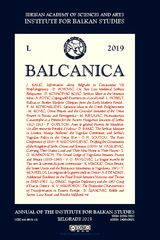Приказ основних података о документу
The Austro-Hungarian Creation of a “Humanitarian” Pretext for the Planned Invasion of Serbia in 1912–1913: Facts and Counter-Facts
| dc.creator | Bjelajac, Mile | |
| dc.date.accessioned | 2020-04-12T10:18:14Z | |
| dc.date.available | 2020-04-12T10:18:14Z | |
| dc.date.issued | 2019 | |
| dc.identifier.uri | https://dais.sanu.ac.rs/123456789/7810 | |
| dc.description.abstract | This paper argues that reporting on the Balkan Wars by some of the Austro-Hungarian media and state officials on the ground was not impartial, but rather aimed to obtain international public support for the planned military intervention against Serbia in late 1912 and mid-1913. The primary task of the newly-established Albanische Korrespondenz Büro or Budapest Korrespondenz Büro was to disseminate horrifying news from the Balkan theatre of war, especially on the alleged Serbian misconduct, to the media in Europe and the United States of America. The famous New York Times, alongside other papers, put those Austrian-made reports on its front pages. Historians believe that influenced the Carnegie Endowment to start a comprehensive inquiry in the aftermath of the Balkan Wars. As early as the spring of 1913 the propagandist and journalist, Leo Freundlich, published in Vienna his still famous book Albania’s Golgotha: Indictment of the Exterminators of the Albanian People, calling out for someone to “stop those barbarians”:“Tens of thousands of defenceless people are being massacred, women are being raped, old people and children strangled, hundreds of villages burnt to the ground, priests slaughtered. And Europe remains silent!” Austria-Hungary mobilized its army, but its ally Germany pulled back. This paper offers facts listed in those reports as well as stories that circulated at the time, along with the Serbian primary sources intended for internal purposes and some narratives of foreign observers on the ground who were often annoyed with the Korrespondenz Büro’s reporting or other papers of the kind. It suggests, however, that responsibility for the atrocities committed in the war still needs to be examined carefully, just like it was concluded long ago:“The wrong they did leave a sinister blot upon their record, but it must be viewed in its just proportion.” | en |
| dc.language.iso | en | sr |
| dc.publisher | Belgrade : Institute for Balkan Studies SASA | sr |
| dc.rights | openAccess | sr |
| dc.rights.uri | https://creativecommons.org/licenses/by-nc/4.0/ | |
| dc.source | Balcanica | sr |
| dc.subject | Austro-Hungary | sr |
| dc.subject | Serbia | sr |
| dc.subject | Balkan Wars | sr |
| dc.subject | “Humanitarian” Pretext | sr |
| dc.title | The Austro-Hungarian Creation of a “Humanitarian” Pretext for the Planned Invasion of Serbia in 1912–1913: Facts and Counter-Facts | en |
| dc.type | article | sr |
| dc.rights.license | BY-NC | sr |
| dcterms.abstract | Бјелајац, Миле; | |
| dc.citation.spage | 131 | |
| dc.citation.epage | 156 | |
| dc.citation.volume | 50 | |
| dc.identifier.doi | 10.2298/BALC1950131B | |
| dc.type.version | publishedVersion | sr |
| dc.identifier.fulltext | https://dais.sanu.ac.rs/bitstream/id/30529/Bjelajac.pdf | |
| dc.identifier.rcub | https://hdl.handle.net/21.15107/rcub_dais_7810 |

